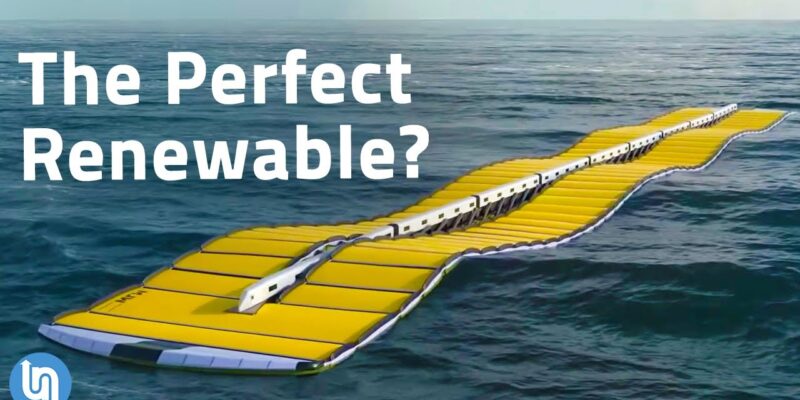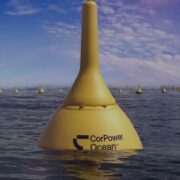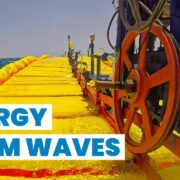
Harnessing the Power of Ocean Waves: A Deep Dive into Wave Energy
Exploring the potential of wave energy as a renewable and consistent source of power.
Overview of Wave Energy
Wave energy is an innovative and sustainable form of renewable energy that harnesses the kinetic energy present in ocean waves. This impressive energy source has gained attention in recent years due to its potential to provide a consistent and environmentally friendly power generation solution. In this blog post, we will delve into the key aspects of wave energy, its advantages, and its potential for widespread adoption.
Harnessing Kinetic Energy from Ocean Waves
At its core, wave energy technology captures the kinetic energy produced by the movement of ocean waves. This energy is then converted into electricity through various methods, such as wave energy converters. By tapping into the natural ebb and flow of the ocean, we can generate clean and renewable power without relying on fossil fuels.
Consistent and Renewable Power Source
One of the significant advantages of wave energy is its consistency as a power source. Unlike solar or wind energy, which can be intermittent depending on weather conditions, ocean waves provide a reliable and consistent energy stream. This predictability makes wave energy a valuable addition to the renewable energy mix.
Water’s Mass for Greater Energy Capture
The mass of water is significantly denser than air, offering a substantial energy capture potential for wave energy technologies. Waves carry immense power within them, and by harnessing this power, we can efficiently generate electricity on a large scale. This high energy density sets wave energy apart from other renewable sources.
Wave Energy Potential Along U.S. Coasts
The United States is blessed with extensive coastlines on both the Atlantic and Pacific oceans, providing ample opportunities for wave energy generation. Regions such as the West Coast, Hawaii, and the Northeastern seaboard boast significant wave energy potential that remains largely untapped. By investing in wave energy infrastructure, the U.S. can further diversify its energy portfolio and reduce dependence on non-renewable sources.
Efficient Conversion for Electricity Generation
Efficiency in converting wave energy into electricity is crucial for the success of wave power projects. Innovations in wave energy converter designs and control systems are continuously improving the efficiency and reliability of wave energy capture. By optimizing the conversion process, we can maximize the electricity output from wave energy installations.
Overall, wave energy holds great promise as a sustainable energy source with the potential to play a significant role in the global transition to clean energy. By leveraging the power of ocean waves, we can reduce our carbon footprint, mitigate climate change, and secure a more sustainable future for generations to come.
Wave Energy Converters (WECs)
Optimized WECs for Successful Wave Energy Generation
Wave Energy Converters (WECs) play a crucial role in harnessing the immense power of ocean waves to generate clean and renewable energy. The optimization of WECs is essential to maximize energy output, increase efficiency, and ensure the sustainability of wave energy generation.
By fine-tuning the design, material selection, and operational strategies of WECs, developers and engineers can overcome technical challenges and capitalize on the vast potential of wave energy. With continuous advancements in technology and research, optimized WECs are paving the way for a more sustainable and environmentally friendly energy future.
Nankun Mobile Power Bank: A Breakthrough in WEC Technology
The Nankun mobile power bank in China represents a significant breakthrough in WEC technology. This innovative device utilizes cutting-edge mechanisms to convert wave motion into electrical power efficiently. The Nankun power bank showcases the potential for small-scale WECs to provide localized energy solutions and contribute to decentralized power generation.
With its portability and ease of deployment, the Nankun mobile power bank offers a practical and versatile solution for coastal communities and remote areas. By harnessing the power of waves, this breakthrough WEC is driving progress towards sustainable energy access and resource optimization.
Competition Among Various WEC Designs for Industry Standardization
The wave energy sector is witnessing intense competition among various WEC designs vying to become the industry standard. From oscillating water columns to point absorbers and attenuators, a diverse range of technologies are being explored and developed to maximize energy capture and conversion efficiency.
Each WEC design comes with its unique strengths and challenges, pushing developers to innovate and refine their approaches. The competition among different WEC technologies is driving rapid advancements in the field, ultimately benefitting the wave energy industry as a whole.
CalWave’s xWave Series: Promising Wave Energy Capture Technology
CalWave’s xWave series represents a promising advancement in wave energy capture technology. By leveraging innovative engineering principles and advanced materials, CalWave has developed WECs that demonstrate high efficiency and reliability in converting wave energy into electricity.
The xWave series embodies CalWave’s commitment to sustainability and performance, offering a glimpse into the future of wave energy generation. With ongoing research and development, CalWave aims to establish its WECs as a leading solution for clean and renewable power generation from ocean waves.
Enhancing Efficiency Through Co-Locating WECs with Offshore Wind
Co-locating WECs with offshore wind farms presents an exciting opportunity to enhance energy generation efficiency and maximize resource utilization. By combining the strengths of wave energy converters with existing offshore wind infrastructure, operators can achieve synergies that lead to improved overall performance.
The integration of WECs alongside offshore wind turbines allows for optimal use of ocean resources and grid connections, creating a more robust and resilient renewable energy system. This collaborative approach not only boosts energy production but also contributes to the evolution of integrated marine energy solutions.
Challenges and Potential
Wave energy converters (WECs) hold great promise as a renewable energy source, yet they are not without their hurdles. The engineering challenges that WECs face in harsh ocean conditions present obstacles that must be overcome for this technology to reach its full potential. Let’s delve into the challenges and potential of wave energy:
Engineering Challenges in Harsh Ocean Conditions
One of the primary obstacles facing wave energy converters is the harsh environment of the ocean. The relentless power of the waves can put immense strain on WECs, requiring them to be highly durable and resilient. Furthermore, the unpredictability of wave patterns adds an additional layer of complexity to the design and operation of these devices. Engineers must develop innovative solutions to ensure that WECs can withstand the harsh ocean conditions and continue to generate energy reliably.
Salt Water, Bio-Fouling, and Corrosion
Another major challenge for wave energy converters is the corrosive nature of salt water. Salt water can cause significant damage to the components of WECs over time, leading to increased maintenance costs and potential downtime. In addition, bio-fouling – the accumulation of marine organisms on the surfaces of WECs – can further exacerbate corrosion issues and reduce the efficiency of these devices. Engineers must find ways to mitigate the impact of salt water, bio-fouling, and corrosion to ensure the longevity and effectiveness of WECs.
xWave Devices and Minimal Impact on Marine Life
Despite the challenges posed by harsh ocean conditions, xWave devices have emerged as a promising solution with minimal impact on marine life. These innovative devices are designed to harness wave energy efficiently while minimizing disturbance to marine ecosystems. By prioritizing environmental sustainability, xWave devices offer a greener alternative to traditional WECs and demonstrate the potential for coexistence between renewable energy generation and marine biodiversity.
High Initial Costs and Maintenance Expenses
One of the main barriers to the widespread adoption of wave energy technology is the high initial costs associated with deploying WECs. The intricate design and construction of these devices require substantial investments, making them less accessible to smaller organizations and communities. Furthermore, the ongoing maintenance expenses of WECs can accumulate over time, further adding to the total cost of ownership. To overcome this challenge, advancements in technology and streamlined manufacturing processes are needed to drive down costs and make wave energy more economically viable.
Wave Energy’s Significant Potential as a Renewable Energy Source
Despite the obstacles that wave energy converters face, wave energy holds tremendous potential as a renewable energy source. The power of ocean waves is abundant and predictable, offering a consistent energy source that can complement other renewable technologies like solar and wind power. With improvements in design, materials, and efficiency, WECs have the capacity to contribute significantly to the global energy mix and help reduce our dependence on fossil fuels.
In conclusion, while challenges persist in the development and deployment of wave energy converters, the potential benefits of this technology cannot be overlooked. By addressing the engineering hurdles, minimizing environmental impact, reducing costs, and maximizing the renewable energy potential of ocean waves, WECs can play a vital role in the transition to a more sustainable energy future.
Future of Wave Energy
Wave energy is a rapidly evolving field with the potential to revolutionize the way we generate clean energy. As technology advances and research continues, the future of wave energy looks promising.
Cost Reduction
The cost of wave energy is expected to decrease over time as technology improves and economies of scale are realized. This downward trend in costs will make wave energy more competitive with other forms of renewable energy, driving its adoption in the energy sector.
Potential Competition
Wave energy has the potential to compete with other renewables such as solar and wind power. With its ability to generate electricity predictably and consistently, wave energy can play a significant role in diversifying the renewable energy mix and reducing reliance on fossil fuels.
Engineering Challenges
The unique engineering challenges associated with harnessing wave energy make it a field that is still in its early stages of development. Innovations in materials, design, and technology are necessary to overcome these challenges and unlock the full potential of wave energy.
Promising Clean Energy Source
Wave energy holds great promise for clean energy generation. By capturing the energy of ocean waves, we can generate electricity without producing greenhouse gas emissions or depleting finite resources. This environmentally friendly approach to energy production is crucial for combating climate change.
Research and Development
Continued research and development are essential for driving the growth of wave energy. By investing in innovation and exploring new ways to harness wave power, we can improve efficiency, reliability, and scalability of wave energy technology. This ongoing effort will propel wave energy forward and position it as a key player in the renewable energy landscape.
TL;DR
Wave energy is poised to become a competitive player in the renewable energy sector, with decreasing costs, potential for competition with other renewables, unique engineering challenges, great promise for clean energy generation, and ongoing research and development driving its advancement.













